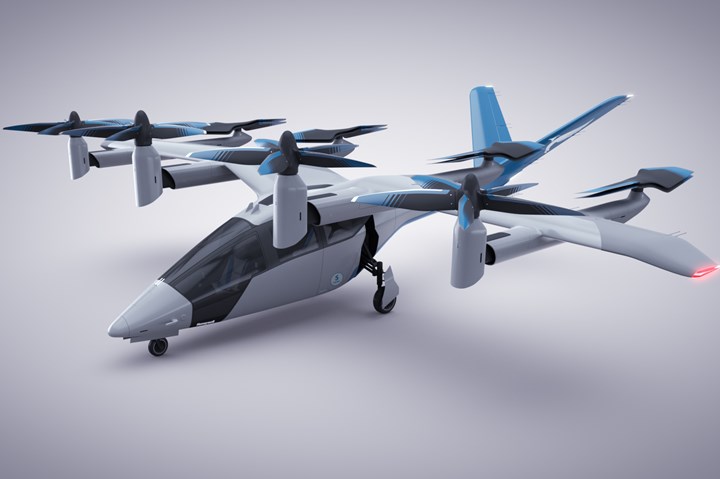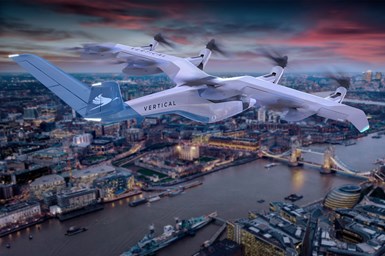Solvay to develop composite structure for Vertical Aerospace eVTOL aircraft
Composite and adhesive technologies will be supplied to Vertical Aerospace for a zero-emissions, all-electric prototype scheduled for a September 2021 test flight.
Share

VA-1X eVTOL aircraft. All photo credit: Solvay
Solvay (Alpharetta, Ga., U.S.) is partnering with Vertical Aerospace (Bristol, U.K.) to develop the composite structure of Vertical Aerospace’s passenger air-taxi program VA-1X (shown above). This piloted, electric vertical takeoff and landing (eVTOL) flagship aircraft will be able to carry four passengers and one pilot for 100 miles (160 kilometers) at cruise speeds of 150 miles per hour/240 kilometers per hour.
As part of the agreement signed by both companies, Solvay will provide access to its extensive composite and adhesive qualified product portfolio and specialized technical and application support both at Solvay’s European Application Centers and at Vertical Aerospace’s office in Bristol, UK. Together, the companies aim to successfully develop the first flying prototype scheduled for a test flight in September 2021.

“Solvay is proud to partner with Vertical Aerospace, a pioneer in sustainable aviation technologies, whose VA-1X aircraft is set to revolutionize the way we travel,” says Carmelo Lo Faro, president of Solvay Composite Materials Global Business Unit. “By providing the performance required to operate safely and maximize range, while facilitating the processes needed for mass production, our advanced materials will be key enablers to the mass-adoption of eVTOLs.”
Solvay and Vertical Aerospace sustainability agendas are reported to be fully aligned. The VA-1X will be electrically powered, where possible by renewable energy, and will offer emission-free flights. The aircraft certification is planned for 2024 with commercial services starting shortly after.
“We are incredibly excited to be working hand in hand with Solvay, co-innovating to develop a lightweight, advanced and sustainable eVTOL thanks to their portfolio of advanced materials,” says Michael Cervenka, CEO of Vertical Aerospace.
Related Content
-
Active core molding: A new way to make composite parts
Koridion expandable material is combined with induction-heated molds to make high-quality, complex-shaped parts in minutes with 40% less material and 90% less energy, unlocking new possibilities in design and production.
-
Nine factors to consider when designing composites cure tooling
Gary Bond discusses the common pitfalls and compromises when designing good cure tooling and their holistic significance for a robust composite production process.
-
The basics of composite drawing interpretation
Knowing the fundamentals for reading drawings — including master ply tables, ply definition diagrams and more — lays a foundation for proper composite design evaluation.














.jpg;maxWidth=300;quality=90)
